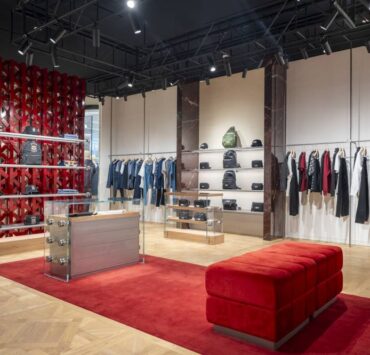Daniel dela Cruz takes ‘lighter, happier’ trip down Alice’s rabbit hole
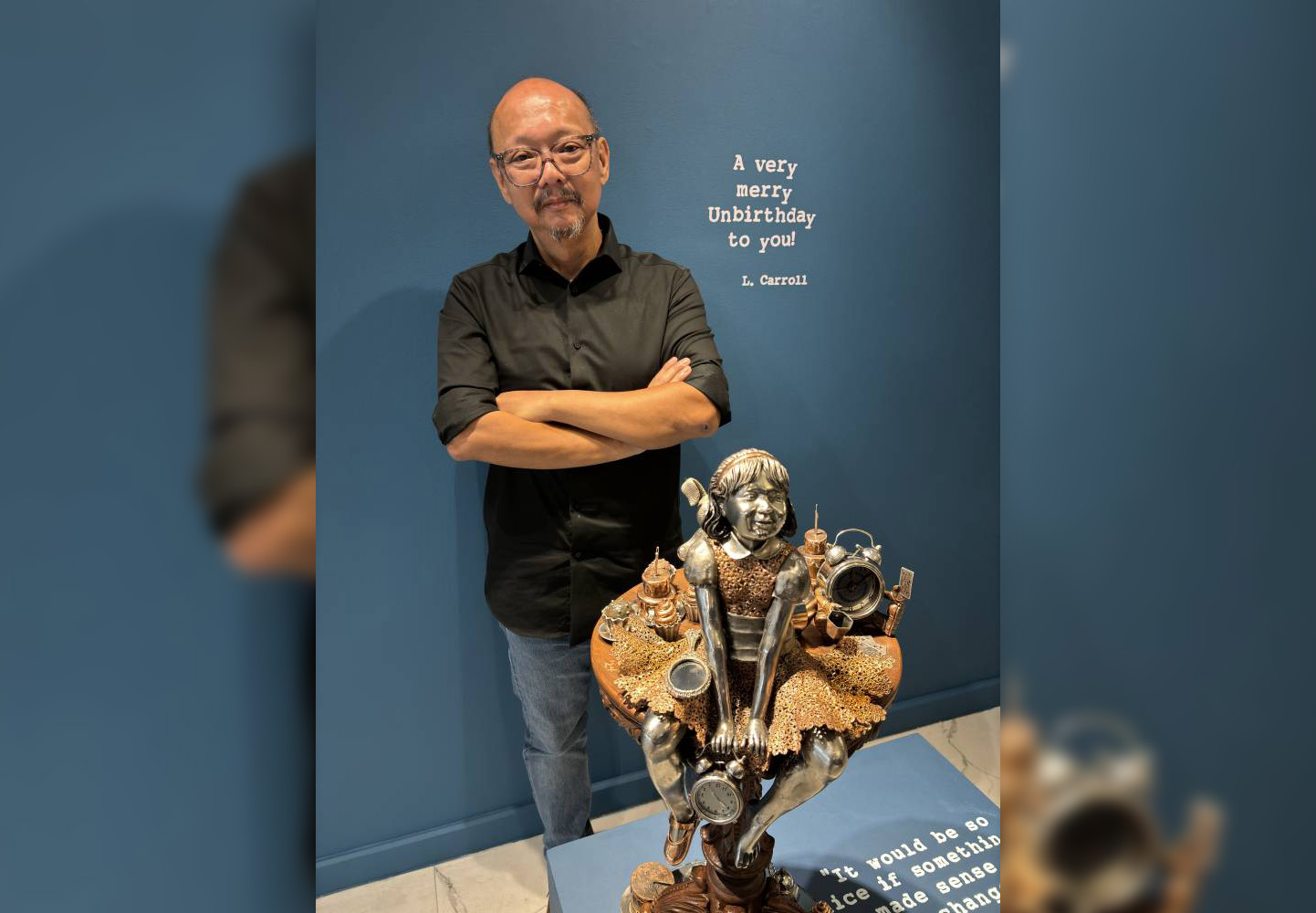
It’s not unusual for sculptor Daniel dela Cruz to start working on a piece not knowing what it would end up looking like.
The concept could have already been simmering in his mind for a while. But nothing is really pre-planned or set in stone. He doesn’t fixate on the specifics, that “this has to be this, or that has to be that.”
But as he continues to work, the sculpture somehow, steers him in the direction it wants to go. Little by little, the details surface, the layers add up, and the picture, at last, begins to take shape.
“I create artworks on the fly. The concept grows and builds up. It tells me what it needs, or what it will go well with. It’s a very spontaneous way of working on things, which I enjoy,” he told Lifestyle.
Before he knows it, Dela Cruz has already fallen down a creative rabbit hole.

Metal sculptures
He most certainly felt that way while neck-deep in work for his ongoing exhibit, “Back at the Tea Party,” a collection of metal sculptures inspired by Lewis Carroll’s children’s book “Alice in Wonderland.”
“As you go deeper and deeper, you get more and more immersed in the process … until it sort of leads you into the world of the exhibit itself,” he said.
In this case, Dela Cruz set things in motion by thinking of unique body poses that would best reflect the titular character’s innocence and youth. From there, the collection gradually revealed itself. And after eight months in that proverbial rabbit hole, Dela Cruz emerged with 28 gleaming art pieces that depict not only Alice’s child-like wonder, but also the eccentricity of the characters she bumps into in the fever-dream dimension she finds herself in.

This isn’t Dela Cruz’s first time delving into the well-loved tale. In 2015, he put up an exhibit called “Curious and Curiouser,” which was more surreal in nature and teetered on the macabre (the Queen of Hearts was a skeleton).
“The first one did very well, so I thought it was about time to revisit the story, because there are still many interesting things in it. The first one I reinterpreted from an adult’s point of view. There were references to drugs, death, and danger,” said Dela Cruz, who has explored more serious themes through his past works, like consumerism in “Material Culture” and mental health in “Finding the Light.”
But in this new outing, Dela Cruz—an avid reader who loved such novels as “Dune” and “Lord of the Rings” back in the day—summoned his inner child and tried to see the world as Alice sees it. “This one is much lighter. I just want to have a happier look at it this time. I tried to take on Alice’s perspective, with her imagination and curiosity,” he said.
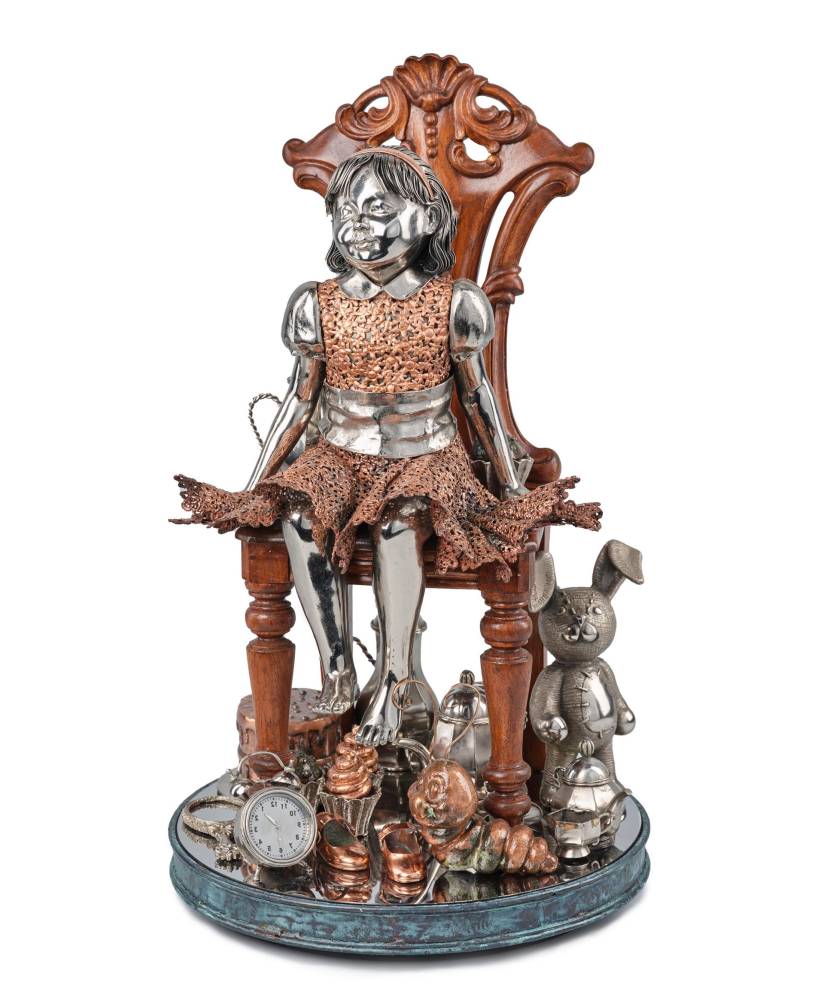
6 key pieces
The six key pieces of the exhibit—which runs until Nov. 17 at the Galerie Joaquin, Rockwell in Makati City—are of Dela Cruz’s different interpretations of the Mad Hatter’s tea party, and the young heroine’s shifting moods amid the awkward and, at times, almost nonsensical sojourn.
Among them are “Happy Unbirthday,” which shows Alice propping herself up on the glass table, lazing around after partaking of the sugary feast around her, and the glass-encased “Whooo Are Youuu,” which features a bemused Alice holding up the Caterpillar in front of her, as if scrutinizing it.
In the wistful “I Seldom Follow My Good Advice,” Alice sits in a rocking chair, hugging her knees and missing one of her shoes. At first glance, she’s seemingly caught in a daydream, her mind adrift to some place else. But in a certain light, the glimmer in her eyes suggests that tears may have been welling up.
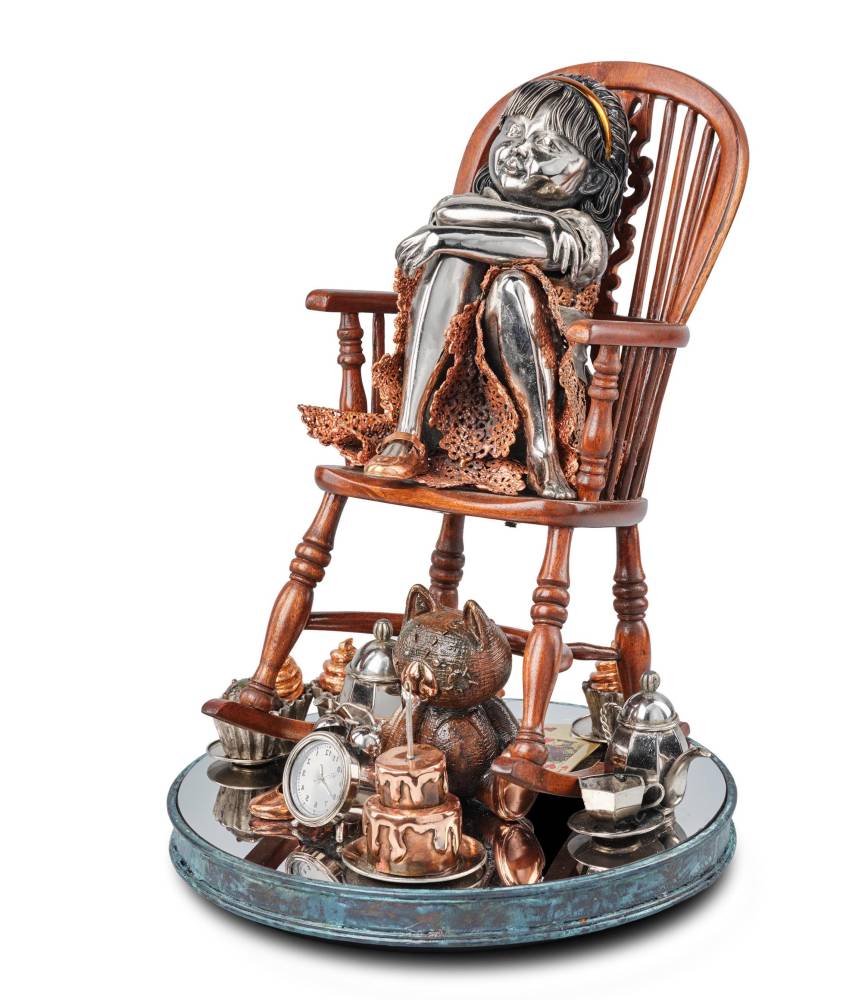
Across all the Alice pieces are recurring elements that tie everything together: the cakes, the bonbons, the dainty teapots and teacups, the sewn stuffed animals, the alarm clocks with flipped faces and hands that run backwards. There’s also a noticeable play on proportions, perhaps an allusion to Alice’s fluctuating height throughout her journey.
In every scene, Alice is placed on hand-carved hardwood furniture, which adds texture and softens the overall look. The pieces—made of mixed metals, including copper—are electroplated with nickel. And the stone blue gallery walls and pedestals—on which excerpts from the book and quotes by Caroll are written—help bring out the richness of the pieces’ earth tones.
And while the set is an exercise in whimsy, there’s a fair bit of humor, too. At some point, it will dawn on you that, in “Happy Unbirthday,” the Dormouse was crafted in Mickey Mouse’s likeness, and the Cheshire Cat, in Garfield’s. Meanwhile, supporting characters, like the Dodo and the March Hare, took a more functional form as shiny teapots.
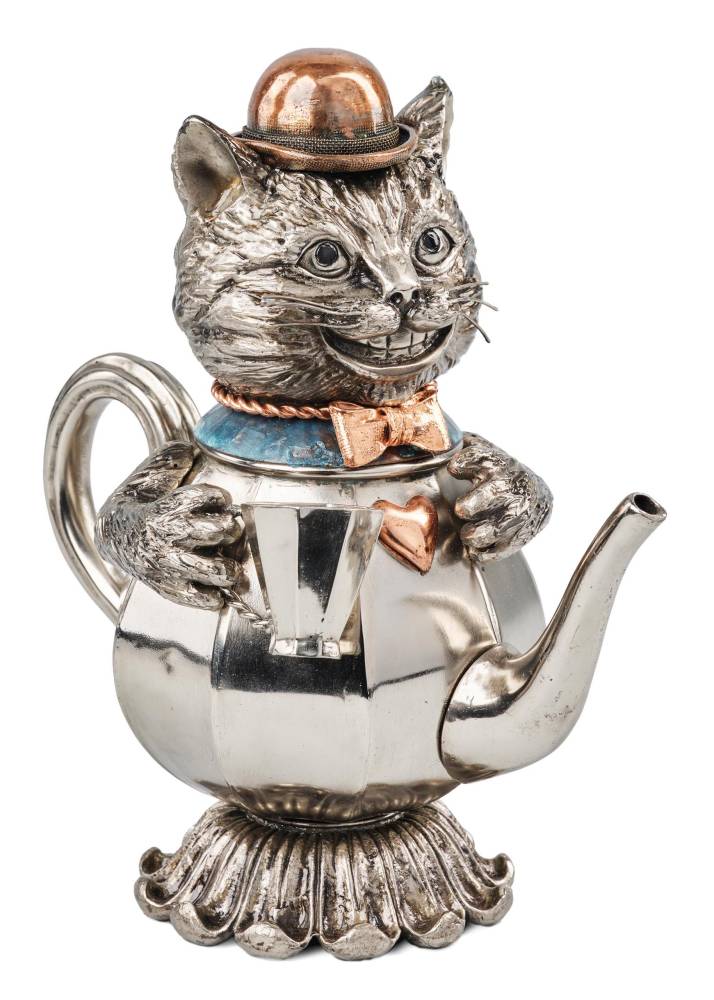
Labor-intensive
As he typically does, Dela Cruz worked on multiple sculptures all at once, each one informing how to shape or embellish the other. Depending on intricacy, a piece can take two to three months. And it’s no wonder why.
Upon closer look, Alice’s skirt is made of countless little doily-like patterns; the bodice, made of florets. And Dela Cruz had to piece all of them together one by one into metal lace—a tedious but necessary process that allowed for greater control in shaping the material as he saw fit. It was what allowed him, for instance, to make the skirt curve along the contours of Alice’s limbs.
“Madugo … nakakabaliw,” Dela Cruz said, laughing, as he took us through the pieces. “The clothes take a lot of patience. It’s time-consuming and labor-intensive. In a way, it’s like applying jewelry-making techniques, but on a larger scale.”
Sculptures of the other characters were just as detailed, from the Queen of Hearts’ wiry strands of hair to the card soldiers’ studded shields and winged helms. “But doing all the tiny details is fun. I enjoy making hard materials look soft,” he said.
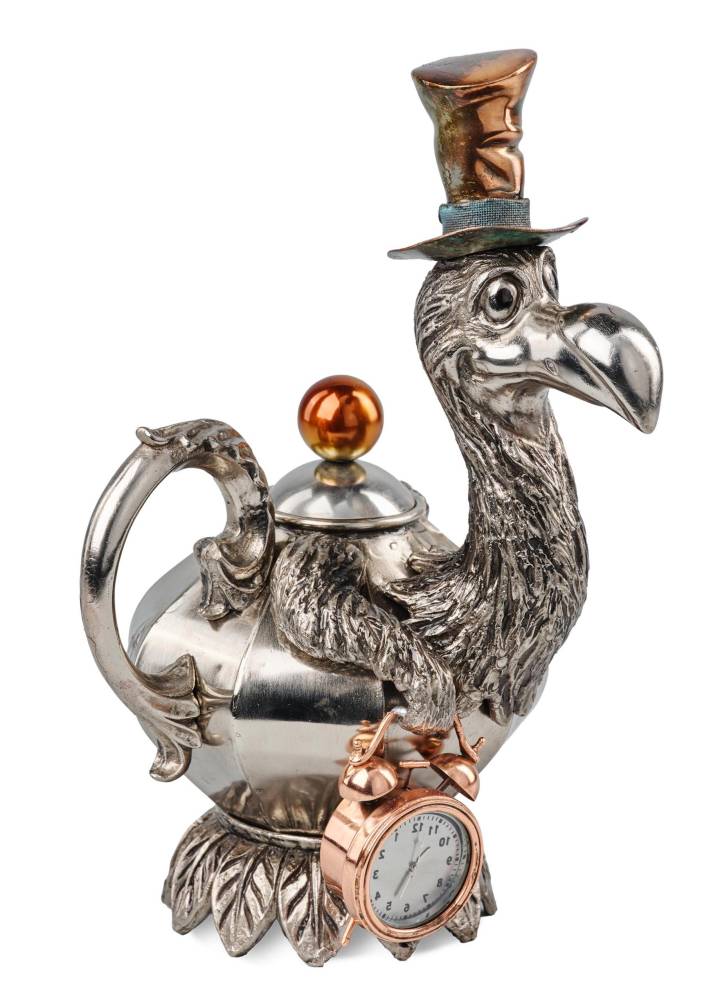
This is exactly what drew Dela Cruz to metals when he decided to pursue a career in visual arts in 2007. In his prior 20 years as a product designer in the export and handicraft industry, he had the opportunity to work with different materials—resin, paper ceramics, shells.
But it was metal, the award-winning artist said, that he felt would challenge him most as an artist. “It’s a rigid medium, which makes it challenging to work with. You have to make the metal conform to the image you have in mind,” he said.
But through years of experience and practice, he managed to come up with his own “unique” approach to metalworking, which allows him to do just that. “I employ all possible techniques—welding, hammering, soldering, casting, electroplating,” he said. “I want to make metal do what I want it to do. And I think I have achieved that by now,” he said.
For Dela Cruz, metal also exudes “permanence.” And perhaps that makes it a fitting medium to capture the sense of fleeting happiness that swaths “Alice in Wonderland.”
“I have always wanted to create things that would outlast me, things that would live on, way past my time,” he said.














